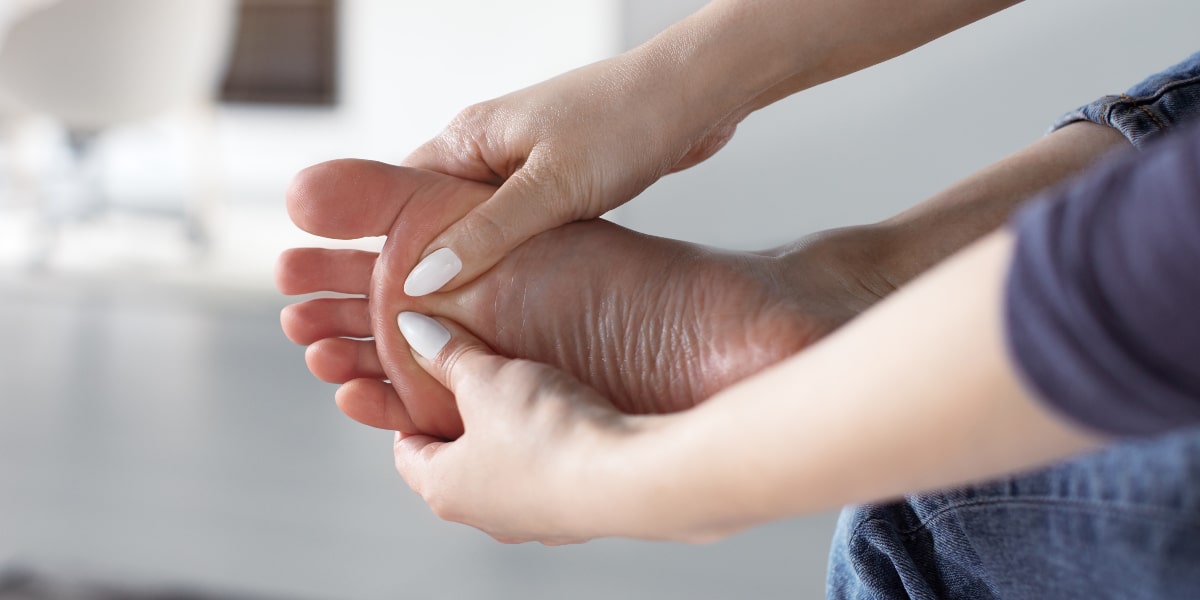Ball of Foot Pain
The ball of your foot is a common location for painful symptoms.
Underneath the padded exterior, this region of the foot is host to a complicated network of metatarsal bones, sesamoids, muscles, connective tissues, nerves, and blood vessels. When you consider how much weight and pressure you put on this part of your foot every day, it’s perhaps no surprise that pain can emerge.
The good news is that most cases of ball of foot pain, also known as metatarsalgia, are not serious and can be treated at home. However, because there are a wide variety of possible conditions—including many that are serious—you should still not underestimate ball of foot pain.
If your pain is severe, does not improve after a few days of rest, or keeps returning, please call our office for an appointment.
What Are the Underlying Causes of Ball of Foot Pain?
Most ball of foot conditions are overuse injuries, and there is often more than one contributing factor. Some of the most common include:
- Structural or biomechanical foot issues. You may have inherited (or acquired, through wear and tear) a foot type that places excess force on the ball of the foot.
- Poor footwear choices. Shoes that don’t provide proper support to the arch, pinch the toes together, or shift your weight to the front of the foot are strongly correlated with ball of foot pain.
- Physical activities. You may be more likely to develop metatarsalgia if you work on your feet, or if you play sports or have active hobbies.
- Being overweight. The heavier you are, the more force you place on the balls of your feet when you stand and walk.

Conditions that Can Cause Pain in the Balls of the Feet
Many different clinical diagnoses can result in ball of foot pain. Beyond simple things like bruises or localized inflammation, some of the more common diagnoses include:
- Morton’s neuroma. This is caused by a thickening in tissue surrounding one of the nerves that lead to your toes—usually between either the second and third, or the third and fourth. It may feel like you’re standing on a pebble or folded sock.
- Capsulitis. This occurs when the “capsule” of ligaments surrounding one of the metatarsal heads becomes irritated, weakened, or unstable. Like Morton’s neuroma, it may feel like you’re standing on a small stone or marble. Left untreated, capsulitis can cause the affected toe to drift out of alignment.
- Stress fractures. Repetitive impacts can gradually weaken the soft tissues in the balls of the feet and force the metatarsal bones to directly take a greater share of the load. Over time, this may lead to painful cracks in the surface of the bones.
- Most people have two small bones called sesamoids in the ball of each foot, near the great toe. These bones are not connected directly to any other bones, but instead act as pulleys to help you elevate the great toe and push off. If these bones become irritated or broken, you may have difficulty bending or straightening your toe.
- Nerve problems. Occasionally, pain in the ball of the foot may be related to a nerve that has become pinched or damaged. You might suspect a nerve injury if you develop tingling, numbness, or pain that feels like burning or shocking.
Resolving Your Ball of Foot Pain
If you are experiencing mild pain in the balls of your feet—for example, aching after the end of a long day—try resting for a few days and using home treatments like ice or over-the-counter NSAIDs.
If pain continues beyond a couple of days, or you notice more distressing symptoms (such as severe pain, shooting sensations, numbness, etc.), give us a call.
Specific treatment recommendations will be based on the diagnosis, the severity of your symptoms, and the underlying causes that are determined. Very often, metatarsalgia can be resolved by using conservative means, such as arch supports and orthotics, footwear changes, lifestyle modifications, physical therapy, or cortisone injections.
Occasionally, surgery might be considered for certain conditions if conservative treatments do not yield the deserved level of relief. One example of this might be surgery to remove a section of nerve tissue irritated by Morton’s neuroma. However, we will always exhaust non-surgical options before recommending a more aggressive approach.
Please, do not let pain in the balls of your feet keep you from living the lifestyle you enjoy. If you find pain is limiting your activities, we can help you find the relief you deserve. Contact InStride Crystal Coast Podiatry in New Bern, NC at (252) 638-4700, or use our online form to request an appointment online.

